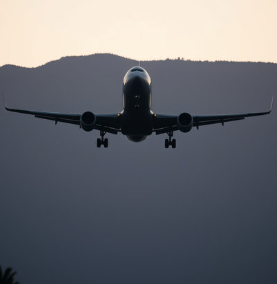In January 2025, the U.S. Department of Transportation (DOT) filed a lawsuit against Southwest Airlines, marking a significant intervention in the ongoing issue of flight delays. The lawsuit targets two of the airline’s flight routes, both of which have been labeled as “chronically delayed” due to a consistent pattern of late arrivals. These disruptions have affected countless passengers, causing them to miss connections, important events, and in some cases, leading to additional financial burdens.
This lawsuit is not just about individual flight delays but serves as a broader reflection of how the airline industry must balance efficiency, customer satisfaction, and operational challenges. The DOT’s action highlights the growing concerns regarding the reliability of air travel in the U.S. and sets a potential precedent for future regulatory actions aimed at improving flight schedules and customer service.
This article will examine the details of the lawsuit, the affected flight routes, the implications for Southwest Airlines, and how this case may affect the airline industry as a whole. The information presented will be based on current developments as of January 2025, providing a comprehensive overview of the case and its potential impact.
What Are “Chronically Delayed” Flights?
The phrase “chronically delayed” is not a casual label—it refers to flights that consistently arrive late over a prolonged period, with significant operational issues contributing to the delays. According to the U.S. Department of Transportation, flights are categorized as chronically delayed if they arrive 30 minutes or more behind schedule more than 50% of the time within a given month. These delays are not random incidents but recurring problems that point to systemic inefficiencies.
Southwest Airlines has come under scrutiny for two of its routes: Chicago Midway to Oakland and Baltimore to Cleveland. Both routes have suffered from repeated delays, causing major disruptions for travelers who rely on these connections for both business and personal reasons. The DOT has brought the lawsuit forward because these delays are not isolated occurrences but have become part of the regular travel experience for passengers on these flights.
The classification of a flight as chronically delayed brings with it serious consequences. It suggests that the airline has not adequately addressed the underlying causes of these delays, such as poor scheduling, understaffing, maintenance issues, or external factors like weather or air traffic congestion. While occasional delays are a normal part of air travel, chronic delays indicate deeper issues that require long-term solutions, which Southwest Airlines has yet to implement effectively.
Passenger dissatisfaction is a critical component of this classification, as chronic delays undermine the trust that travelers place in airlines to provide timely and reliable service. The DOT’s decision to intervene is an indication that passenger rights are being compromised, and more stringent measures may be needed to ensure that airlines prioritize on-time performance.
The Affected Flight Routes:
The DOT’s lawsuit highlights two specific Southwest Airlines routes: Chicago Midway to Oakland and Baltimore to Cleveland. These routes were chosen because they consistently fall within the category of chronically delayed flights. Below, we explore the details of each route and the reasons behind their persistent delays.
1. Chicago Midway to Oakland
The flight between Chicago Midway International Airport (MDW) and Oakland International Airport (OAK) has been a point of concern for Southwest Airlines. Passengers flying on this route have experienced frequent delays, often due to a combination of factors.
One of the main challenges faced by this route is its timing. Departing during peak travel hours, the flight is often impacted by heavy air traffic at both Chicago and Oakland airports. Air traffic congestion, especially during busy times of the day, can delay flights before they even leave the ground. Additionally, once in the air, these flights may experience further delays due to heavy air traffic over major U.S. flight paths.
In addition to air traffic delays, Southwest Airlines has faced operational difficulties with staffing and aircraft maintenance. On multiple occasions, passengers reported mechanical delays that resulted in extended wait times on the tarmac. These delays have become an unfortunate norm, with the airline struggling to reduce them. Despite ongoing complaints from passengers, Southwest has yet to make significant improvements to the service on this route.
For many travelers, delays on this route have become a major inconvenience. Business travelers have reported missing meetings and important appointments, while vacationers have had to rebook their travel plans. The consistency of these delays has led to frustration and a growing number of complaints, which ultimately caught the attention of the DOT.
2. Baltimore to Cleveland
The flight between Baltimore/Washington International Thurgood Marshall Airport (BWI) and Cleveland Hopkins International Airport (CLE) has been another major source of frustration for Southwest Airlines passengers. Similar to the Chicago to Oakland route, this flight has experienced a high rate of delays, often exceeding 30 minutes.
This route, while not as heavily impacted by air traffic congestion, suffers from issues related to staffing and weather disruptions. Winter months, in particular, can cause delays due to snow and icy conditions, especially in Cleveland. However, the issue goes beyond weather-related factors. Passengers have reported inconsistent communication from the airline regarding the status of delayed flights. In some cases, travelers were left waiting for hours without updates on the situation, adding to the inconvenience.
For travelers between these two cities, chronic delays have resulted in missed connections, rebooking headaches, and additional expenses. The lack of improvement on this route, despite ongoing complaints, prompted the DOT to take legal action. Southwest Airlines’ failure to resolve the delays has now made it a subject of government scrutiny, which could have broader implications for the airline’s operations across its entire network.
The Impact of Delayed Flights on Passengers
Chronic delays have far-reaching consequences that extend beyond the immediate inconvenience of waiting at the airport. For passengers, the impact of these delays can be profound, especially when they result in missed connections, disrupted plans, and financial losses.
Business Travelers
For business travelers, time is often of the essence. A delayed flight can mean missing important meetings or opportunities, which could lead to financial losses for individuals or companies. Furthermore, missed connections due to delays can result in additional hotel stays and meal costs, which can quickly add up. Many business travelers rely on the punctuality of their flights to maintain their schedules, and chronic delays undermine the reliability that they expect from airlines.
Vacationers and Families
For families and vacationers, chronic delays are equally disruptive. Families with children may struggle with the logistics of waiting for extended periods, especially if the delay happens overnight. For families traveling to important events, such as weddings or reunions, the frustration is compounded by the possibility of missing key moments. Additionally, vacationers who plan carefully to maximize their time may feel their trip is wasted due to extended delays.
Financial Costs
Passengers often bear the financial costs associated with delays. In some cases, delayed flights can lead to additional expenses, such as hotel stays, meals, and transportation. Some passengers have reported being forced to book new flights when the delays extend beyond a reasonable window. These financial implications are not just inconvenient—they can put significant pressure on travelers, especially those on tight budgets.
Emotional Toll
The emotional toll of waiting at the airport with little to no information is another consequence of chronic delays. Passengers are often left in limbo, unsure of when they will be able to board their flights. This sense of uncertainty, coupled with the lack of effective communication from the airline, can lead to frustration, stress, and feelings of helplessness. In some cases, this emotional toll is compounded by missed opportunities and the inability to return home on time.
Given these consequences, it’s clear that chronic delays do more than inconvenience passengers—they can have a lasting impact on their personal and professional lives. The DOT’s intervention is a response to these challenges, seeking to hold Southwest Airlines accountable for the disruption caused to travelers.
Southwest Airlines’ Response to the Lawsuit
Southwest Airlines has publicly expressed disappointment over the DOT’s lawsuit, stating that it does not believe the delays on these routes reflect the overall performance of its network. The airline attributes the delays to a variety of factors, including weather disruptions, air traffic congestion, and seasonal staff shortages. While Southwest acknowledges that delays have occurred, the airline maintains that these are not indicative of a broader systemic issue.
To address the concerns raised by the DOT, Southwest Airlines has promised to take further steps to improve on-time performance. The airline plans to invest in new technologies to streamline its operations, reduce delays, and better manage staffing during peak travel periods. Southwest has also pledged to improve its communication with passengers, ensuring that travelers are kept informed about any delays or changes to their flight schedules.
Despite these assurances, the DOT’s lawsuit raises important questions about the adequacy of Southwest Airlines’ response to chronic delays. The lawsuit signals that the government is not satisfied with the airline’s efforts thus far and that further action is necessary to protect passengers’ rights and ensure reliable air travel.
Legal and Financial Implications for Southwest Airlines
The DOT’s lawsuit carries significant legal and financial implications for Southwest Airlines. If the court rules in favor of the DOT, Southwest may face substantial fines and be required to take corrective actions to improve its performance on the affected routes. These corrective actions could include revising flight schedules, adding additional staff, or investing in new technologies to better manage delays.
In addition to the direct legal consequences, a ruling against Southwest Airlines could have long-term reputational effects. The airline’s image as a low-cost carrier that offers reliable service could be tarnished if it is found responsible for chronic delays. Passengers who have been affected by the delays may seek compensation, leading to potential legal settlements. This could further damage the airline’s brand loyalty and impact its market share.
Moreover, Southwest Airlines may face increased regulatory scrutiny, not only from the DOT but also from other government agencies. Airlines may be forced to adopt stricter standards for on-time performance and passenger communication, potentially reshaping the way the industry operates.
The Future of Airline Operations and Accountability
The outcome of the DOT’s lawsuit could have wide-reaching consequences for the airline industry as a whole. If Southwest Airlines is found liable for the chronic delays, other airlines may face similar legal challenges if they fail to meet certain performance standards. The case could set a precedent that forces airlines to adopt more rigorous operational measures to prevent delays and improve customer service.
In the future, passengers may see more stringent requirements for on-time performance, better communication regarding delays, and faster compensation for those who are affected. Airlines may also be required to disclose more detailed data about their on-time performance and operational challenges, providing greater transparency for travelers.
The lawsuit also underscores the role that government regulators are beginning to play in holding airlines accountable for their operational failures. The DOT’s intervention serves as a reminder that airlines must prioritize customer satisfaction and operational efficiency in order to remain competitive and maintain public trust.
The DOT’s lawsuit against Southwest Airlines is a significant development in the airline industry. It represents a growing demand for greater accountability, transparency, and reliability from airlines, particularly when it comes to minimizing flight delays and ensuring passenger satisfaction. While Southwest Airlines has made efforts to address the issues, the lawsuit reflects the DOT’s determination to protect passengers’ rights and ensure that chronic delays do not become the norm.
As the case progresses, the airline industry will closely watch the outcome, which could reshape how airlines manage their operations and communicate with passengers. The focus on improving the quality of service and operational efficiency is a critical step in ensuring the future of air travel in the U.S. and restoring confidence in the reliability of flight schedules.
Feel free to check out our other website at : https://scoremaxed.com/











